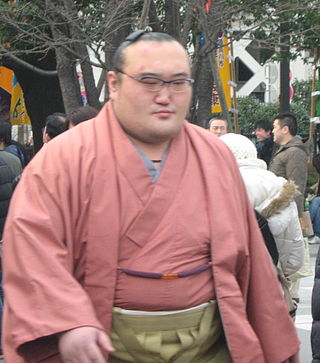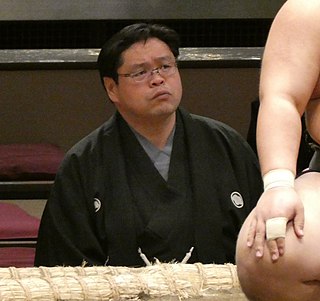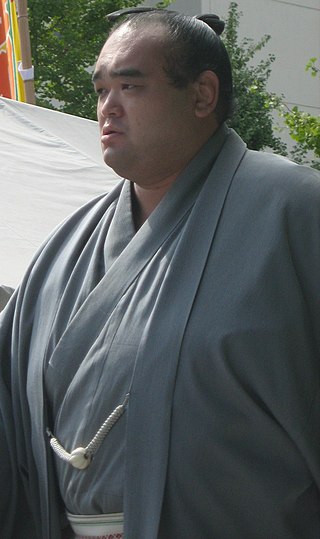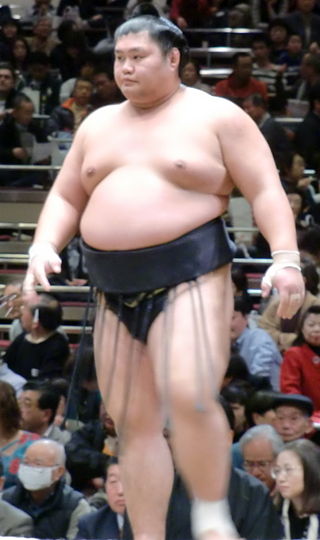Related Research Articles

Miyabiyama Tetsushi is a former sumo wrestler from Mito, Ibaraki, Japan. A former amateur champion, he turned professional in 1998. With the exception of two tournaments, he was ranked in the top division of professional sumo from 1999 until the end of his career in 2013, holding the second highest rank of ōzeki from 2000 to 2001. He won eight special prizes and was runner-up in four top division tournaments. He wrestled for Fujishima stable, where he worked as a coach until opening his own Futagoyama stable.

Iwakiyama Ryūta, is a former sumo wrestler. A former amateur sumo champion, he turned professional in 2000 and reached the top division at the end of 2002. The highest rank he reached was komusubi. He was a runner-up in one tournament and earned two special prizes in his career. After his retirement in 2010 he became an elder of the Japan Sumo Association under the name Sekinoto.

Tosanoumi Toshio, is a former sumo wrestler. He first reached the top division of professional sumo in 1995, winning 13 special prizes and earning 11 kinboshi or gold stars for defeating yokozuna over his long career. The highest rank he reached was sekiwake. He retired in 2010 to become a coach at his stable, Isenoumi stable under the name of Tatekawa.

Tochinonada Taiichi is a former sumo wrestler from Ishikawa Prefecture, Japan. An amateur sumo champion, he turned professional in 1996 and reached the top makuuchi division in 1997. He earned twelve kinboshi or gold stars for defeating yokozuna, the second highest ever, and he was a runner-up in two tournaments. His highest rank was sekiwake. He is now a coach at Kasugano stable under the name Takenawa Oyakata.

Wakanosato Shinobu is a retired sumo wrestler from Hirosaki, Aomori, Japan. He made his debut in the top division in 1998, and his highest rank was sekiwake. He holds the record for the most consecutive tournaments ranked in the junior san'yaku ranks of sekiwake and komusubi. He won ten special prizes and was twice runner-up in a tournament. He earned two gold stars for defeating yokozuna at a maegashira rank. He had 1691 career bouts, sixth on the all-time list. He retired in 2015 and was a coach at Tagonoura stable, until opening his own Nishiiwa stable in February 2018.

Takekaze Akira is a former professional sumo wrestler from Akita Prefecture, Japan. A former amateur sumo champion, he turned professional in 2002, reaching the top makuuchi division the following year. He was a runner-up in one tournament, earned two special prizes for Fighting Spirit, and one gold star for defeating a yokozuna. Takekaze is in first place for the slowest promotion from makuuchi debut to the third highest sekiwake rank in history. Aged 35 years and two months, he is in first place for the eldest to make his sekiwake debut post World War II. He was a member of Oguruma stable. He retired in January 2019 to become an elder of the Japan Sumo Association under the name Oshiogawa-oyakata.
Hitoshi Tochihana is a former Japanese sumo wrestler from Yamagata, Iwate. A former amateur champion, he turned professional in 1995, reaching the top makuuchi division in 2000. His highest rank was komusubi. He retired in 2008 and is now a sumo coach.

Jūmonji Tomokazu is a former sumo wrestler from Aomori, Japan. Joining the professional ranks in 1992, he reached the top division in 2000 and was ranked there for 34 tournaments until 2007. His highest rank was maegashira 6. He was forced to retire in April 2011 after an investigation by the Japan Sumo Association found him guilty of match-fixing.
Wakatoba Hiromi is a former sumo wrestler from Fuchū, Tokyo, Japan. His highest rank was maegashira 11.
Misugisato Kōji is a former sumo wrestler from Shiga Prefecture, Japan. He made his professional debut in 1979, and his highest rank was komusubi which he reached in 1989. He earned six gold stars for defeating yokozuna and one special prize for Fighting Spirit. He retired in 1998 and became an elder of the Japan Sumo Association before leaving the sumo world in 2006.

Bushūyama Takashi is a Japanese former sumo wrestler from Aomori, Aomori Prefecture. He made his professional debut in January 1999. At the age of 32, he was promoted to the top makuuchi division in the November 2008 tournament. His highest rank was maegashira 3. He is now a sumo coach.
The following are the events in professional sumo during 2004.
The following are the events in professional sumo during 2003.
The following are the events in professional sumo during 2002.
The following are the events in professional sumo during 2001.
The following are the events in professional sumo during 2000.
Hamanoshima Keishi is a former sumo wrestler from Uto, Kumamoto Prefecture, Japan. A former amateur champion, he turned professional in 1992, reaching the top makuuchi division in 1994. His highest rank was komusubi. After his retirement from active competition in 2004 he became an elder of the Japan Sumo Association and founded Onoe stable in 2006, which has produced a number of top division wrestlers.

Wakakōyū Masaya is a former professional sumo wrestler from Funabashi, Japan. His highest rank was komusubi. The last two characters of his ring name were taken from his mentor and coach at Ōnomatsu, the former Masurao. He was only the second wrestler from his stable to reach the top division. He was runner-up in one tournament and earned one special prize, for Fighting Spirit. He is now a sumo coach.

Ōikari Tsuyoshi is a former sumo wrestler from Kyoto, Japan. He made his professional debut in March 1995, and reached the top division in November 1998. His highest rank was maegashira 11. He retired in November 2004, and as of 2016 he is an elder in the Japan Sumo Association under the name Kabutoyama.
Shinji Hamada, better known as Toyonoumi Shinji, was a Japanese sumo wrestler from Buzen, Fukuoka. He made his professional debut in March 1981 and reached the top division in November 1988. He was known by the shikona Takanohama until 1990. His highest rank was maegashira 1. He did not miss a single bout in his 19-year professional career. Upon retirement from active competition he became an elder in the Japan Sumo Association, under the name Yamahibiki. He left the Sumo Association in June 2002.
References
- ↑ "Daishi Nobuyuki Kabu History". Sumo Reference. Retrieved 10 September 2012.
- 1 2 "「ジーニー候補」芋洗坂係長&大至 "プロ"に負けぬ美声披露" (in Japanese). Sponichi. 18 November 2014. Retrieved 10 November 2016.
- ↑ Perran, Thierry (October 2005). "Danpatsu-shiki of Musoyama Masashi, the 232nd Ozeki". Le Monde Du Sumo. Retrieved 8 December 2016.
- ↑ Gunning, John (26 May 2019). "Sumo 101: Sumo and singing". Japan Times. Retrieved 27 May 2019.
- ↑ "Daishi Nobuyuki Rikishi Information". Sumo Reference. Retrieved 7 September 2012.